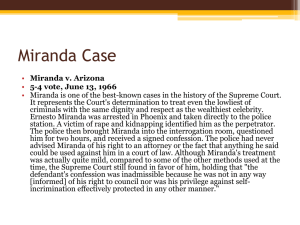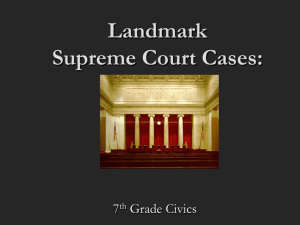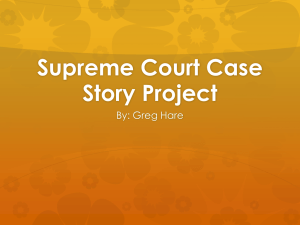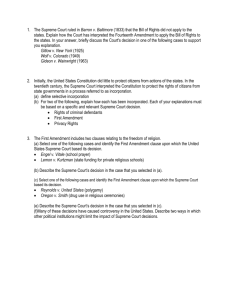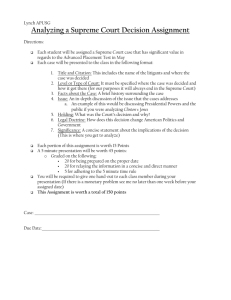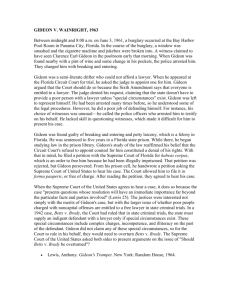Landmark Supreme Court Cases: Marbury v. Madison (1803)
advertisement
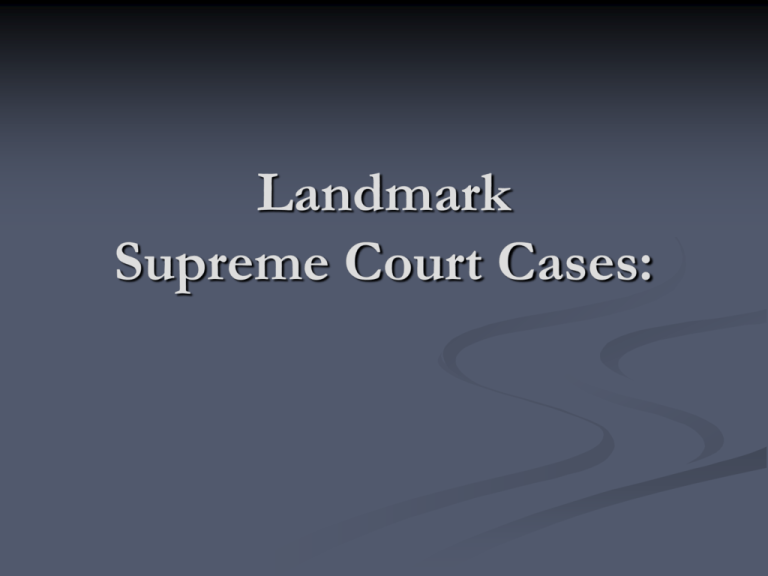
Landmark Supreme Court Cases: Marbury v. Madison (1803): William Marbury was appointed justice of the peace by John Adams the day before he left office. Thomas Jefferson (the new president), cancelled Marbury’s appointment. Marbury asked the Supreme Court rule on the case based on the Judiciary Act, which enabled him to take his case directly to the Supreme Court. The Supreme Court ruled that the Judiciary Act itself was unconstitutional and Marbury lost his case. The decision established “judicial review”: the evaluation of federal laws’ constitutionality as a power of the Supreme Court The Supreme Court has the ability to review laws, cases, decisions, etc. and judge their constitutionality. Dred Scott v Sanford (1857) In March of 1857, the United States Supreme Court, led by Chief Justice Roger B. Taney, declared that all blacks -- slaves as well as free -- were not and could never become citizens of the United States. The court also declared the 1820 Missouri Compromise unconstitutional, thus permitting slavery in all of the country's territories. Became impetus for the Civil War. 1. All slaves were to be considered property with no rights of citizenship. 2. One of factors that led to Civil War and the creation of the 14th Amendment. Plessy v. Fergusson (1896): A Louisiana law required separate seating for white and African Americans on public railroads (segregation). --Herman Plessy said his 14th Amendment rights (Equal Protection Clause) had been violated. --The Supreme Court ruled that his rights were not violated, and segregated public facilities were permitted until 1954. Created the concept of Separate but equal. Brown v. Board of Education of Topeka (1954) 10-year-old, Linda Brown, was not allowed to attend her neighborhood school because she was African American. --Linda Brown said her 14th Amendment rights (Equal Protection Clause) had been violated. --The Supreme Court ruled that “separate but equal” segregation was a violation of the Equal Protection Clause. This decision overturned the precedent established by Plessy v. Ferguson in 1896. - Led to the Integration of schools. Mapp v. Ohio (1962): Dollree Mapp was convicted of having obscene materials in her home. Mapp appealed the conviction, saying that the police had violated her rights by entering her house without a warrant. The Supreme Court overturned the lower court’s decision, saying that the police had acted improperly, this excluding the evidence that they had found. “Exclusionary Rule”: excludes all evidence that is found in illegal police searched. Gideon v. Wainwright (1963): Clarence Gideon was found guilty of breaking and entering and sentenced him to 5 years in prison. Gideon appealed claiming that he had been unconstitutionally denied counsel during trial due to Florida’s policy of only providing legal counsel in capital areas. Gideon received a new trial (with a court-appointed attorney) and was found not guilty. “The Gideon Rule”: guarantees counsel to all poor persons facing a felony charge (6th Amendment). Miranda v. Arizona (1966): Ernesto Miranda was arrested for kidnapping and sexual assault – he signed a full confession including a statement that he “had full knowledge of his legal rights.” Miranda appealed claiming that he had not received warning or legal council to guide his decision to confess. The Supreme Court agreed with Miranda, saying that all suspects must be forewarned that they have the right to remain silent and the right to an attorney. “Miranda Rule”: before a suspect is arrested by police, he/she must be: The Miranda Rights: 1. Told of their right to remain silent. 2. Warned that whatever they say may be used in court. 3. Informed of their right to an attorney. 4. Informed that an attorney will be provided if they cannot afford one. 5. Told that they can stop police questioning at any time. Gregg v. Georgia (1976): Troy Gregg was sentenced to death after being found guilty of 2 counts of armed robbery and 2 counts of murder. Gregg appealed claiming that the sentence violated the “cruel and unusual punishment” clause of the 8th Amendment. The Supreme Court denied the appeal, stating for the first time that “the death penalty does not invariably violate the Constitution”. New Jersey v. T.L.O. (1985): T.L.O. (a New Jersey high school student) was sentenced to probation by juvenile court after a vice-principal searched her purse and found cigarettes and marijuana. T.L.O. appealed the ruling saying the principal’s search was unreasonable. The Supreme Court denied the appeal, saying that schools are allowed more leeway when conducting searches. The Court created a “reasonable suspicion” rule for schools conducting searches, instead of the “probable cause” rule that exists for the rest of society. California v Acevedo Stated that if a police officer has probable cause that they may search a vehicle for an item without a search warrant. Ruling was that the 4th amendment does not pertain to a container in a vehicle and that the police with probable cause could search without a warrant. Tinker v Des Moines School District John and Mary Beth Tinker of Des Moines, Iowa, wore black armbands to their public school as a symbol of protest against American involvement in the Vietnam War. When school authorities asked that the Tinkers remove their armbands, they refused and were subsequently suspended. The Supreme Court decided that the Tinkers had the right to wear the armbands, with Justice Abe Fortas stating that no one expects students to “shed their constitutional rights to freedom of speech or expression at the schoolhouse gate.” Right to free speech as long as it did not interrupt the normal activity of a school. Roe v Wade (1973) Roe (P), a pregnant single woman, brought a class action suit challenging the constitutionality of the Texas abortion laws. These laws made it a crime to obtain or attempt an abortion except on medical advice to save the life of the mother. Other plaintiffs in the lawsuit included Hallford, a doctor who faced criminal prosecution for violating the state abortion laws; and the Does, a married couple with no children, who sought an injunction against enforcement of the laws on the grounds that they were unconstitutional. The defendant was county District Attorney Wade (D). Ruling: State criminal abortion laws that except from criminality only lifesaving procedures on the mother’s behalf, and that do not take into consideration the stage of pregnancy and other interests, are unconstitutional for violating the Due Process Clause of the Fourteenth Amendment.
